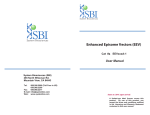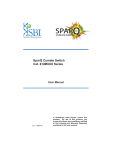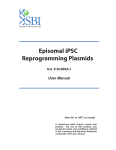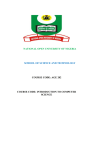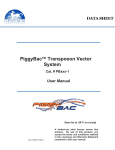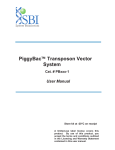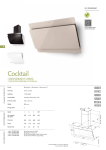Download EEV Vector System User Manual
Transcript
Enhanced Episome Vectors (EEV) . EEVxxxA-1 Cat #s User Manual System Biosciences (SBI) 265 North Whisman Rd. Mountain View, CA 94043 Tel: 888.266.5066 (Toll Free in US) 650.968.2200 Fax: 650.968.2277 E-mail: [email protected] Web: www.systembio.com Store at -20ºC upon arrival A limited-use label license covers this product. By use of this product, you accept the terms and conditions outlined in the Licensing and Warranty Statement contained in this user manual. EEV Episomal Vector System Cat. #s EEV6xxA-1 Contents I. Introduction ..............................................................................1 A. Enhanced Episomal Vectors (EEV) Overview ....................2 B. EEV Applications and Vector Formats ................................3 II. EEV Reporters and Sample Data ............................................5 A. Constitutive and Inducible EEV Reporter Construct Maps .5 B. Sample EEV Reporter Expression Data .............................6 III. Product Information and Protocols.....................................12 IV. Frequently Asked Questions ..............................................13 V. References .........................................................................14 VI. Technical Support ..............................................................14 VII. Licensing and Warranty information ..................................15 888-266-5066 (Toll Free) 650-968-2200 (outside US) Page 1 System Biosciences (SBI) A. User Manual Enhanced Episomal Vectors (EEV) Overview For many years, expression vectors have been used as tools for providing transgenic information into mammalian cultured cells and therapeutic studies. For example, reprogramming factors were shown to be delivered through retroviral transduction in cells, allowing any somatic cell to differentiate, much like human ES cells. However, viral transduction systems have many challenges for in vivo studies due to potential for random integration and mutagenesis. To avoid the challenges of viral transduction systems, nonviral, non-integrating plasmid-based expression and reprogramming vectors such as those based on the Epstein-Barr Nuclear Antigen1 (oriP-EBNA1) have been developed. They have been validated to efficiently reprogram fibroblasts into induced Pluripotent Stem Cells (iPSCs) without integrating or modifying the host’s genome (SBI’s catalog # SC900A-1). The major distinguishing feature of the EBNA system from viral or other plasmid-based approaches is its ability to replicate in synchrony with the host genome by attaching to the host chromatin and replicate with each cell cycle division. This results in an extended presence within a host cell. The target gene to be expressed (such as a reporter or iPSC reprogramming factors) can be expressed in the same plasmid as the oriP-EBNA1 factor for sustained transgene expression. Over time, these episomal plasmids are naturally lost at a rate of 5% per cell cycle division due to plasmid dilution, promoter silencing, and vector replication errors. Since most of the plasmid is lost over time, cell lines can then be established without any risk of genomic integration or alterations. SBI has developed an enhanced version of the oriP-EBNA1 technology called the Enhanced Episomal Vector (EEV) platform. This new technology enables sustained transgene expression for several months in both in vitro and in vivo applications. The mechanism of how the EEV technology works is shown in the next schematic. Page 2 ver. 7-050415 www.systembio.com EEV Episomal Vector System B. Cat. #s EEV6xxA-1 EEV Applications and Vector Formats EEV vectors are a non-viral and non-integrating system for sustained transgene expression in cells. The built-in oriP-EBNA1 gene in these vectors allows these plasmids to be replicated and partitioned to daughter cells. As a result, this EEV system is optimized to be expressed in cell culture and in vivo animal models for up to 6 weeks The EEV platform has been utilized by SBI to rapidly and efficiently reprogram somatic cells into iPSCs – for additional information, please see product description for SBI’s Episomal iPSC Reprogramming Plasmids, cat# SC900A-1. The EEV system is optimal for researchers looking for a non-viral, nonintegrating system to provide long-term, stable transgene expression in target cells or tissues, and offers clear advantages over both viral and traditional plasmid-based expression systems. Highlights of the EEV System Easy to clone format, no special plasmid production requirements Nonviral, non-integrating technology Persistent, sustained transgene expression Powerful CAGs promoter for constitutive, high level transgene expression in all mammalian cell types, including primary and stem cells Tight, inducible Cumate Switch format available 888-266-5066 (Toll Free) 650-968-2200 (outside US) Page 3 System Biosciences (SBI) User Manual EEV Cloning Vector Formats SBI has built two formats of EEV cloning and expression vectors to build your own constructs. The first features a potent CAGs promoter driving constitutive transgene expression (Cat# EEV600A-1). The second is an inducible EEV expression vector that features the ultra-tight cumate inducible system in an all-inone format (catalog# EEV610A-1). Both vector formats feature a Multiple Cloning Site (MCS) to insert a cDNA, microRNA, etc. sequence into the EEV vector as well as the EBV oriP origin and the EBNA1 factor for propagating the episome for sustained transgene expression. The available cloning and expression EEV vector formats are shown below. Page 4 ver. 7-050415 www.systembio.com EEV Episomal Vector System I. Cat. #s EEV6xxA-1 EEV Reporters and Sample Data A. Constitutive and Inducible EEV Reporter Construct Maps SBI has built EEV reporter plasmids featuring a GFP-T2ALuciferase expression cassette for reporting sustained transgene expression in a constitutive format (cat# EEV604A-1) or as an allin-one cumate inducible format (cat# EEV605A-1). The construct plasmid maps are depicted below. 888-266-5066 (Toll Free) 650-968-2200 (outside US) Page 5 System Biosciences (SBI) User Manual B. Sample EEV Reporter Expression Data EEV in vitro applications The constitutive EEV reporter construct cat# EEV604A-1 was transfected into HEK293T cells and the GFP transgene expression monitored over a period of several weeks. HEK293T cells in a 24well culture dish were transfected once with 0.5 ug of EEV604A-1 reporter plasmid DNA. Cell images from 2 days and 11 days after transfections are shown below. The cumate inducible EEV reporter construct (cat# EEV605A-1) features a cumate-inducible promoter driving the expression of GFP-T2A-Luciferase as well as a constitutive EF1 promoter expressing the CymR cumate promoter repressor and a Puromycin selection cassette. HEK293 cells were transfected with EEV605A-1. Cells were cultured with DMEM supplemented with 10% FBS. The EEV605A-1 cumate switch inducible reporter Page 6 ver. 7-050415 www.systembio.com EEV Episomal Vector System Cat. #s EEV6xxA-1 should be silent until the addition of the inducer cumate solution (Cat# QM150A-1, 10,000x concentration). Cumate was added at a concentration from the 10,000x stock daily at a final concentration in the medium of 300 ug/ml and cells imaged for GFP induction. The GFP induction appeared after 2 days and then expression was detected for 72 days (2.5 months) after the original transfection under 2 ug/ml puromycin selection. The GFP induction data for the no cumate and the 11 and 72 day expression data are shown in the next Figure. 888-266-5066 (Toll Free) 650-968-2200 (outside US) Page 7 System Biosciences (SBI) User Manual The expression activity of the EEV605A-1 reporter plasmid upon cumate induction can also be monitored in living cells for luciferase expression. Simply add D-luciferin to the cell media for 2-3 minutes and image the cells for luminescence. An example is shown below of a 6-well dish of HEK293T cells transfected with EEV605A-1 as well as control untransfected cells. Both conditions then were either treated with 1x cumate solution or no cumate. Cells were subcultured in cumate for 27 days and imaged for 120 seconds to detect luminescence using a Bio-Rad Chemi-doc system. The resulting cumate induction data in living cells with the EEV605A-1 reporter are shown in the next Figure. EEV in vivo applications The constitutive EEV604A-1 CAGs-GFP-T2A-Luciferase construct (8 ug plasmid DNA) was introduced into test mice through hydrodynamic tail vein injection (HDD). This procedure leads to high plasmid DNA transfection of the livers of mice in vivo. The test mice (n=3) were imaged for body luminescence in the liver area post HDD from Day 1 up until Day 80. The results show that robust EEV luciferase expression is readily detectable at very high Page 8 ver. 7-050415 www.systembio.com EEV Episomal Vector System Cat. #s EEV6xxA-1 levels through Day 40. Luciferase quantitative data for the test mice in graphical form as well as bioluminescent animal imaging data are shown in the next Figure. There are some popular episomal expression technologies available for sustained expression in vivo, such as the Minicircle DNA system (Mark A. Kay, et al., Nat Biotechnol. 2010 Dec;28(12):1287-9 and Mini-Intronic Platform (Lu J, et al., Mol Ther. 2013 May;21(5):954-63). These two different episomal technology platforms were compared against the EEV system using a mouse IL-23 cDNA followed by HDD injection with subsequent monitoring of secreted mIL-23 protein levels in the serum of test mice. Two different amounts of either minicircle, mini-intronic platform or EEV plasmid DNA expressing the mIL-23 gene were utilized for these cross-comparison studies. Serum levels of mIL-23 expression were quantitated using a murine IL-23 ELISA assay 7 days after HDD injection of the various plasmid DNAs. 888-266-5066 (Toll Free) 650-968-2200 (outside US) Page 9 System Biosciences (SBI) User Manual The EEV construct map of the mIL-23 EEV expression construct cloned into EEV600A-1 and the mIL-23 serum expression data are shown above. The EEV technology outperformed the other episomal platforms by at least 10-fold over the course of these studies up to 21 days post-HDD injection (not shown). This demonstrates the ability of the EEV platform to provide sustained, long-lasting transgene expression which is critical for endpoint studies requiring weeks or even months of transgene expression. The Cumate inducible EEV605A-1 reporter was also tested in mice. The EEV605A-1 CuO-GFP-T2A-Luciferase plasmid was introduced into test mice (n=3) by using 5 ug plasmid and the HDD injection procedure on Day 0. The water-soluble version of the inducer cumate compound (cat# QM150A-1) was injected by IP Page 10 ver. 7-050415 www.systembio.com EEV Episomal Vector System Cat. #s EEV6xxA-1 (1.5 mg) per animal to induce EEV expression. The mice were then imaged for luminescence activity through full body scans and liver expression levels quantitated from Day 2 through Day 10. The experimental setup is depicted below. The controls for the experiments included a naïve, no plasmid DNA control, as well as EEV605A-1 injected mice (n=3) without the addition of cumate. The results for the Day 2 measurements are shown in the next figure. 888-266-5066 (Toll Free) 650-968-2200 (outside US) Page 11 System Biosciences (SBI) II. User Manual Product Information and Protocols Product Format, Storage, Stability and Availability EEV plasmids are shipped at a concentration of 0.5 ug/uL with 10 ug total. All plasmids are shipped in dry ice or blue ice and should be stored at -20°C upon receipt. Properly stored plasmids are stable for 12 months from the date received. Building EEV expression constructs Standard molecular cloning techniques to insert the cDNA, microRNA, etc. of interest can be used and placed into the MCS of the EEV cloning and expression vector. Typical ampicillin-based plates and liquid media can be used to identify successful clones and propagate the EEV plasmids. Transfection of EEV vectors in Tissue Culture For 293 FT cells in a 24-well plate format: One day prior to transfection, seed 1.0 x 10^5 cells/well in a 24-well plate Cells should be 60-80% confluent on day of transfection. Replace cells with fresh new media at least 2 hours prior to transfection. Transfection method (recommended) 1. Per 24-well to be transfected: 2. First dilute 0.5 ug EEV plasmid in 100 uL Dilution media (Serum-Free), then mix well. 3. Add 2-3 uL of Lipofectamine LTX reagent and mix by gently flicking the tube and spin down briefly. 4. Incubate at 25°C for at least 30 minutes. 5. Then take 100 uL of transfection mix and add drop-wise to the cells. 6. Let plasmid express for 24-72 hours. Establishing EEV cell lines EEV600A-1 and EEV604A-1 are constitutive promoters which allow sustained expression of EEV plasmids and target gene for at least 6 weeks. Page 12 ver. 7-050415 www.systembio.com EEV Episomal Vector System III. Cat. #s EEV6xxA-1 EEV610A-1, EEV605A-1 are inducible systems that have a cumate promoter and a puromycin marker for selecting and establishing cell lines. EEV604A-1 and EEV605A-1 also feature a GFP-T2ALuciferase reporter to monitor expression of EEV both invitro and in-vivo animal studies. Frequently Asked Questions Q. What is the cDNA maximum size that can be expressed from an EEV plasmid? Although the insert size limits have not been thoroughly tested, we have had success in expressing up to a 12 kb insert at high levels using the EEV system. Q. Will the EEV plasmids work in Human, Mouse and Rat cells? Yes, the EBNA1 and oriP vector technologies will work in most mammalian cells and tissue types. Q. How can I control/reduce the expression level of my cloned cDNA in an EEV plasmid? If your cDNA is cloned into the constitutive expression plasmid (cat# EEV600A-1), then simply titrate down the amount of EEV construct DNA you use for cell transfections and/or animal injection studies. Alternatively, you can use the cumate inducible EEV format (cat# EEV610A-1) and titrate in the amount of cumate added to achieve the desired expression level. 888-266-5066 (Toll Free) 650-968-2200 (outside US) Page 13 System Biosciences (SBI) IV. User Manual References Daramola O, Stevenson J, Dean G, Hatton D, Pettman G, Holmes W, Field R. A high-yielding CHO transient system: coexpression of genes encoding EBNA-1 and GS enhances transient protein expression. Biotechnol Prog. 2014 Jan-Feb;30(1):132-41. John L. Yates, Noreen Warren & Bill Sugden. Stable replication of plasmids derived from Epstein–Barr virus in various mammalian cells. Nature 313, 812 - 815 (28 February 1985); doi:10.1038/313812a0. Mark A. Kay, Cheng-Yi He & Zhi-Ying Chen. A robust system for production of minicircle DNA vectors. Nat Biotechnol. 2010 Dec;28(12):1287-9. Lu J, Zhang F, Kay MA.A mini-intronic plasmid (MIP): a novel robust transgene expression vector in vivo and in vitro. Mol Ther. 2013 May;21(5):954-63. V. Technical Support For more information about SBI products and to download manuals in PDF format, please visit our web site: http://www.systembio.com For additional information or technical assistance, please call or email us at: System Biosciences (SBI) 265 North Whisman Rd. Mountain View, CA 94043 Phone: (650) 968-2200 (888) 266-5066 (Toll Free) Fax: (650) 968-2277 E-mails: General Information: [email protected] Page 14 ver. 7-050415 www.systembio.com EEV Episomal Vector System Cat. #s EEV6xxA-1 Technical Support: [email protected] Ordering Information: [email protected] VII. Licensing and Warranty information Please note the following Licensing Restrictions: For Academic and Non-Profit Institutions: Researchers at academic and non-profit institutes are granted full access to purchasing the EEV cloning vectors and reporters. Full sequence information is provided upon proof of purchase of EEV vectors. Please contact SBI’s technical support at [email protected] for sequence information. For Commercial Customers: For-profit and commercial customers can purchase the pre-made EEV reporters (EEV604A-1, EEV605A-1); however, due to licensing restrictions, cloning EEV vectors (e.g. EEV600A-1 and EEV610A-1) are not available for purchase directly. Instead, these are available through SBI’s custom EEV cloning and production services. SBI then provides the commercial customer with the desired amount of ready-to-use EEV custom construct DNA. Limited Use License Use of the EEV vector system (i.e., the “Product”) is subject to the following terms and conditions. If the terms and conditions are not acceptable, return all components of the Product to System Biosciences (SBI) within 7 calendar days. Purchase and use of any part of the Product constitutes acceptance of the above terms. The purchaser of the Product is granted a limited license to use the Product under the following terms and conditions: 888-266-5066 (Toll Free) 650-968-2200 (outside US) Page 15 System Biosciences (SBI) User Manual The Product shall be used by the purchaser for internal research purposes only. The Product is expressly not designed, intended, or warranted for use in humans or for therapeutic or diagnostic use. The Product may not be resold, modified for resale, or used to manufacture commercial products without prior written consent of SBI. This Product should be used in accordance with the NIH guidelines developed for recombinant DNA and genetic research. Purchase of the product does not grant any rights or license for use other than those explicitly listed in this Licensing and Warranty Statement. Use of the Product for any use other than described expressly herein may be covered by patents or subject to rights other than those mentioned. SBI disclaims any and all responsibility for injury or damage which may be caused by the failure of the buyer or any other person to use the Product in accordance with the terms and conditions outlined herein. Limited Warranty SBI warrants that the Product meets the specifications described in this manual. If it is proven to the satisfaction of SBI that the Product fails to meet these specifications, SBI will replace the Product or provide the purchaser with a credit. This limited warranty shall not extend to anyone other than the original purchaser of the Product. Notice of nonconforming products must be made to SBI within 30 days of receipt of the Product. SBI’s liability is expressly limited to replacement of Product or a credit limited to the actual purchase price. SBI’s liability does not extend to any damages arising from use or improper use of the Product, or losses associated with the use of additional materials or reagents. This limited warranty is the sole and exclusive warranty. SBI does not provide any other warranties of any kind, expressed or implied, including the merchantability or fitness of the Product for a particular purpose. Page 16 ver. 7-050415 www.systembio.com EEV Episomal Vector System Cat. #s EEV6xxA-1 SBI is committed to providing our customers with high-quality products. If you should have any questions or concerns about any SBI products, please contact us at (888) 266-5066. © 2015 System Biosciences (SBI), All Rights Reserved. 888-266-5066 (Toll Free) 650-968-2200 (outside US) Page 17


















